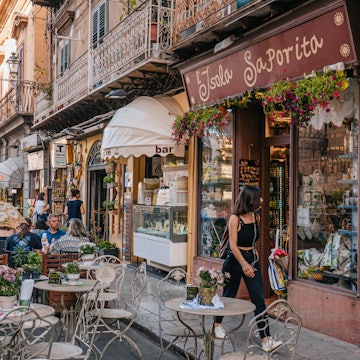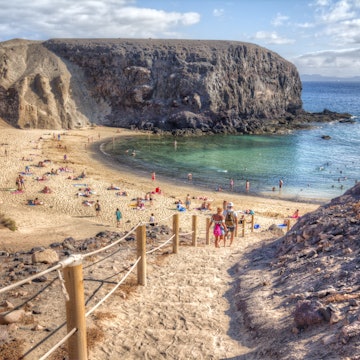
Everything you need to know about visiting Barcelona on a budget

Oct 23, 2024 • 6 min read

Peruse Barcelona's markets and enjoy a delicious picnic at a cut price. Shutterstock
Barcelona packs a lot into its city limits, from world-class architecture around every corner and ornate museums to a thriving nightlife and incredible attractions. It's no wonder visitors flock here every year without fail and one visit is never enough.
However, all these wonderful things to see and do bring a downside – budget-busting prices. Barcelona is the most expensive city in Spain when it comes to cost of living and your must-see list can quickly spiral out of control given the options. Even those who have spent time in Spain before will notice the difference in affordability.
But don't despair! There are plenty of savings to be made compared to other major European cities, especially if you've got insider tips and tricks to guide you. This is everything you need to know about stretching your budget in Barcelona.
Average daily costs
Hostel room: €55 (US$60)
Basic room for two: €170 (US$184)
Self-catering apartment (including Airbnb): €220 (US$238)
Public transportation ticket: €2.55 (US$2.75)
Coffee: €1.50 (US$1.62)
Sandwich: €5.50 (US$6)
Dinner for two: €40 (US$43.25)
Beer/pint at the bar: €4 (US$4.32)
Sagrada Familia Basic Ticket: €26 (US$28.11)

1. Get the Aerobus from the airport
A cab from the airport to the city center will cost you at least €35 Euros (US$38) each way, but a round-trip Aerobús ticket is only €12.50 (US$13.50). A bus departs right outside both airport terminals and goes as far as Plaça Catalunya but also makes stops in Plaça Espanya and Universitat.
You could also take the metro from the airport if it gets you closer to your destination, but you may have a few transfers to make, which won’t be fun if you’re towing around heavy luggage.
2. Time your visit with the first Sunday of the month
If you’re still early in the planning stage, time your trip so you’ll be in Barcelona on the first Sunday of the month. On this day, many of the city’s biggest museums open their doors for free, including the Picasso Museum, the Maritime Museum, the Museum of Urban History of Barcelona, the National Art Museum of Catalonia, Montjuïc Castle and more.
3. A winter trip is cheaper but still wonderful
This isn’t just a budget travel tip (of course, you will find cheaper rates in the off-season) because Barcelona in the winter is quite underrated. The winter season brings round traditions that summer tourists never experience, like calçot barbecues and Llum, a festival of lights that takes place every winter in the Poblenou neighborhood.
You could also plan a budget-friendly day of skiing nearby – take the train up to the Pyrenees and enjoy some of the cheapest resort prices in Western Europe.

4. Stay outside the historic center
The city center is home to most of Barcelona’s historic landmarks, especially if you’re interested in Barcelona’s Roman origins and its medieval period, but it tends to be more touristy and expensive. You’ll likely find cheaper accommodations and restaurants if you stay in one of the peripheral neighborhoods like Gràcia, Poble Sec or Poblenou, where each district's charm is an attraction in itself. For cheaper options, consider further-out neighborhoods like Sants, Les Corts or Clot. It will take longer to get around, but the savings are worth the effort.
5. Take advantage of public transportation
Public transportation in Barcelona is efficient and safe, and although you have to be wary of potential pickpockets, it’s one of the best ways to get around the city. Day passes for unlimited rides are available, but unless you’re staying somewhere outside the city center, it's usually cheaper to buy a single ticket or a 10-pack to use as needed.
6. Don’t assume Airbnb will be the best option
Airbnb is basically a dirty word in Barcelona – the backlash against the platform has been strong. The government has responded with strict regulations and crackdowns on illegal listings. Barcelona's mayor announced plans in June 2024 for a total ban on short-term rentals to tourists by 2028. For travelers, that means there’s not a lot out there, and the prices reflect that. It’s always worth checking, but you should strongly consider hostels and hotels before you make a final decision.

7. Walk when you can
Barcelona is a highly walkable city, especially when you’re exploring the historic center. Its narrow medieval streets form a labyrinth that’s truly fun to get lost in, with lots of hidden corners to discover. If you can manage longer strolls and have lots of time, bigger distances like Gràcia to Arc de Triomphe or Plaça Catalunya to La Sagrada Familia are also quite doable.
8. Pack a picnic
When the weather is nice – which it usually is – the people of Barcelona love a picnic. You’ll see al fresco dining everywhere: sprawled out on the grassy stretches of Parc de la Ciutadella, at the beach and in the gardens on top of Montjuïc. Rather than paying for a big lunch, a picnic is a great way to save money and pick up your charcuterie supplies as you explore one of the local markets.

9. Don’t eat near big attractions
It’s not hard to get high-quality food in Barcelona for a reasonable price, but any restaurant near major attractions, like those in the immediate vicinity of La Sagrada Familia or lining La Rambla, will have neither. Thankfully, all you need to do is walk a few blocks, and you should be able to find something more reasonable and authentic.
10. Look out for the menus of the day
At lunchtime, you’ll notice a lot of restaurants in Barcelona offering their “Menu del Dia,” which is a deal that typically offers two courses, a drink and dessert. It depends on the restaurant, but prices range between €10 and €20 (US$10.80-21.60). Portions do tend to be a bit smaller for these set menus, but you get more variety and enough food to fuel you for the second half of the day.

11. Graze on tapas and pintxos
If you don’t need a big meal every few hours, Barcelona is the perfect city for you. You can grab tapas and share a few small plates or find a bar selling pintxos. You’ll usually see the bite-sized morsels on display through a glass window, and there’s always something fun to try, like mini cups of gazpacho, olive and anchovy skewers, or even tiny hamburgers. Most include a bread element, so you’ll fill up fast, and each will only cost you between €1 and €5 (US$1.08-5.40), depending on the ingredients.
12. Join a free walking tour
In any city, this is the best way to get your bearings, and in Barcelona, you have a lot of options. If you’ve never done a free walking tour before, bear in mind that a tip is expected at the end, but the amount is up to you. Free Walking Tours offers regular outings, plus themed walks that focus on the work of Gaudí or a particular neighborhood. Free Tours by Foot also offers market tours and one that focuses on the city’s role during the backdrop of the Spanish Civil War.
13. Enjoy the architecture from the outside
There is a lot of beautiful architecture in Barcelona, and you could go broke if you try to see it all in one trip. Tickets to the major Gaudí attractions like La Pedrera (€28/US$30) and Casa Batlló (€29/US$31.35) are pricey, and they can get very crowded and claustrophobic. Think carefully about which landmarks are a priority for your visit versus the ones you can appreciate from the outside.















